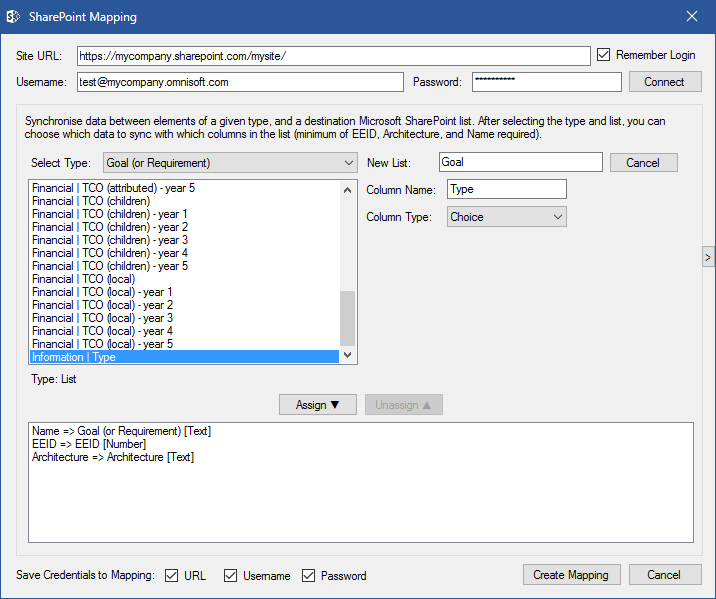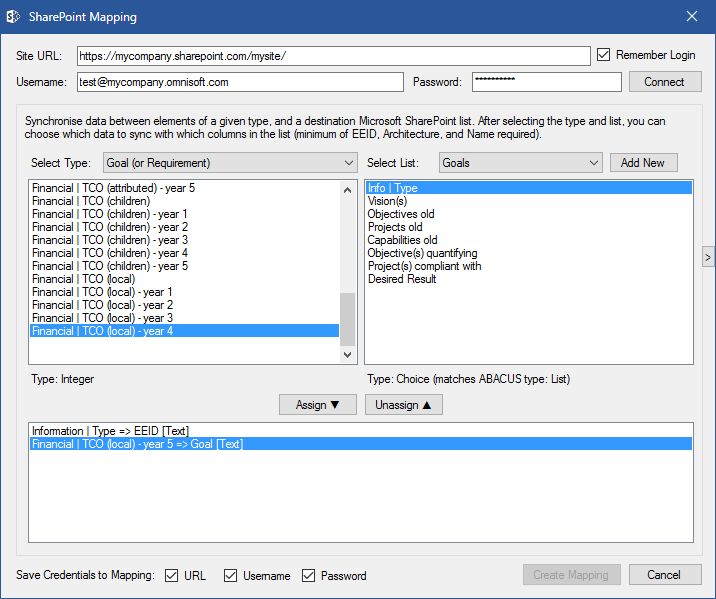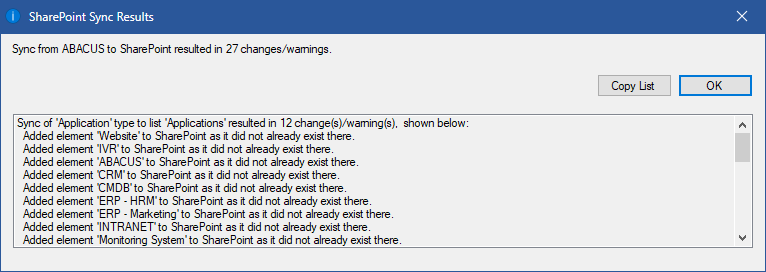|
You can synchronise your architecture with Microsoft SharePoint lists. Synchronisation involves either creating new SharePoint lists (and their columns) from ABACUS types, their properties and attachments, or mapping existing SharePoint lists (and their columns) to ABACUS types, their properties and attachments, then either sending content from ABACUS to SharePoint or SharePoint to ABACUS.
 Note Note
The SharePoint Sync feature requires that a Microsoft SharePoint 2010, 2013 or SharePoint Online site is available to connect to and synchronise with. While the SharePoint Sync feature can create lists (with columns) on a SharePoint site from any ABACUS project, Avolution can also provide various SharePoint site templates in support of standard frameworks (e.g. TOGAF, ArchiMate, ITIL etc) so please contact Avolution Support if you require this capability.
 Note Note
SharePoint sites using languages other than English as the default language from the following that are officially supported include: Arabic, Dutch, German, Spanish and Turkish.
You will be given a warning when trying to connect to a SP site with an unsupported default language.
 Note Note
Items newly created on SharePoint from Collaboration files will be given a negative EEID to represent their temporary state. Due to the possibility of conflicts with EEID's, these items on SharePoint will only be finalised on the next sync with the mappings after committing your changes where the SharePoint items EEID will be either turned positive or given the new EEID of the item it is sync'd with that was resolved for the conflict. The mapping will be finalised regardless of whether the sync is to or from SharePoint .
 Note Note
To use Browser authentication, enable Use Browser-Based SharePoint Authentication in Tools | Options. For MFA enabled SharePoint websites, enable the Use Modern SharePoint Authentication option instead.

SharePoint Sync Dialog
To create a new SharePoint list and map it to an ABACUS component or connection type
1.Ensure you have ABACUS open.
2.Select Tools | SharePoint Sync.
3.Click the New Mapping button and a SharePoint Mapping dialog as shown below will appear.
4.Enter the Site URL, Username and Password for the SharePoint site and click Connect.
 Note Note
A valid SharePoint 'admin' or 'contributor' account is required to sync from and to SharePoint and a 'reader' account will only allow sync from SharePoint.
 Note Note
When changing the SharePoint site you are syncing with, the lookups for attached components will need to be re-mapped even if the mappings are properly labelled otherwise they will be left out of synchronisation when syncing to and from the site.
5.Select the ABACUS component or connection type to map from the Select Type pull-down.
6.Click the Add New button and then for each ABACUS component or connection type aspect you wish to map to a corresponding SharePoint list field select an item in the left panel and in the right panel enter the new SharePoint list name in the New List column (only the first time), then the SharePoint column name in the Column Name (or use the default) and click Assign each time.
 Note Note
As a minimum to allow synchronisation the ABACUS EEID, Architecture and Name aspects will be automatically mapped to a SharePoint Number and two (2) Single line of text (aka Text) columns respectively. These can not be unassigned. Furthermore, only certain ABACUS aspects can currently be mapped to certain SharePoint columns and the Column Type pull-down will be automatically set to the required SharePoint column type. Namely;
•ABACUS' Hierarchy Path to SharePoint Multiple lines of text (aka Note) columns (Note: SharePoint Single line of text (aka Text) columns only support 255 chars so they are not preferred),
•ABACUS' Attached Components to SharePoint Lookup columns (Note: A mapping must already exist to a list for the attached components themselves and in the case where multiple mappings for a type are present the first mapping will be used),
•ABACUS' Text and Description properties to SharePoint Multiple lines of text (aka Note) columns (Note: SharePoint Single line of text (aka Text) columns only support 255 chars so they are not preferred), (Also note: If an ABACUS' Text property is used for storing URLs, it can be mapped to a SharePoint URL column.),
•ABACUS' Decimal or Integer properties to SharePoint Number columns,
•ABACUS' List properties to SharePoint Choice columns (Note: SharePoint does not enforce the choice values so the List data type does not need to be enforced in ABACUS),
•ABACUS' Date/Time properties to SharePoint Multiple lines of text (aka Note) columns (Note: SharePoint Date and Time columns can't be used as yet due to SharePoint's inconsistent support for timezone / regionalization settings),
•ABACUS' Boolean properties to SharePoint Yes/No (aka Boolean) columns.
An ABACUS element's Associated Standards can not be mapped to SharePoint list columns as yet.
7.Select Create Mapping.

SharePoint Mapping Dialog 1
To create a new mapping between an ABACUS component or connection type and an existing SharePoint list
1.Ensure you have ABACUS open.
2.Select Tools | SharePoint Sync.
3.Click the New Mapping button and a SharePoint Mapping dialog as shown below will appear.
4.Enter the Site URL, Username and Password for the SharePoint site and click Connect.
 Note Note
A valid SharePoint 'admin' or 'contributor' account is required to sync from and to SharePoint and a 'reader' account will only allow sync from SharePoint.
5.Select the ABACUS component or connection type to map from the Select Type pull-down.
6.Select the SharePoint site list to map from the Select List pull-down.
7.For each ABACUS component or connection type aspect you wish to map to its corresponding SharePoint list column select an item in the left panel and the right panel respectively and click Assign.
 Note Note
As a minimum to allow synchronisation the ABACUS EEID, Architecture and Name aspects need to be mapped to a SharePoint Number and then for Architecture and Name to either Single line of text (aka Text) or Multiple lines of text (aka Note) columns respectively. Until that is done the Create Mapping button will not be enabled. Furthermore, only certain ABACUS aspects can currently be mapped to certain SharePoint columns. Namely;
•ABACUS' Architecture aspect to a SharePoint Single line of text (aka Text) or Multiple lines of text (aka Note) columns (this is required for content specific mapping as described below),
•ABACUS' Hierarchy Path to SharePoint Single line of text (aka Text) or Multiple lines of text (aka Note) columns (Note: SharePoint Single line of text (aka Text) columns only support 255 chars so any additional characters will be truncated and therefore it is recommended to convert them to Multiple lines of text (aka Note) columns in SharePoint before mapping),
•ABACUS' Attached Components to SharePoint Lookup columns (Note: A mapping must already exist to a list for the attached components themselves),
•ABACUS' Text and Description properties to SharePoint Single line of text (aka Text) or Multiple lines of text (aka Note) columns (Note: SharePoint Single line of text (aka Text) columns only support 255 chars so any additional characters will be truncated and therefore it is recommended to convert them to Multiple lines of text (aka Note) columns in SharePoint before mapping), (Also note: If an ABACUS' Text property is used for storing URLs, it can be mapped to a SharePoint URL column.),
•ABACUS' Decimal or Integer properties to SharePoint Number columns (Note: SharePoint Calculated columns can be used however they will only be able to synchronised from SharePoint to ABACUS. Trying to sync 'to' a calculated column will result in a warning as per below),
•ABACUS' List properties to SharePoint Choice columns,
•ABACUS' Date/Time properties to SharePoint Multiple lines of text (aka Note) columns (Note: SharePoint Date and Time columns can't be used due to SharePoint's inconsistent support for timezone / regionalization settings),
•ABACUS' Boolean properties to SharePoint Yes/No (aka Boolean) columns.
An ABACUS element's Associated Standards can not be mapped to SharePoint list columns as yet. And SharePoint's Currency, Person or Group, Hyperlink or Picture, Task Outcome, External Data and Managed Metadata columns can not be mapped to ABACUS aspects as yet.
8.Select Create Mapping.

SharePoint Mapping Dialog 2
To synchronize your Microsoft SharePoint list(s) into ABACUS
1.Ensure you have ABACUS open.
2.Select Tools | SharePoint Sync.
 Note Note
To synchronise a SharePoint list with an ABACUS project the user license needs the SharePoint Sync add-on capability. Please contact your local ABACUS Administrator or Avolution Support if you require this capability.
3.Select an existing SharePoint mapping (or mappings using Ctrl-click or the Select All button) from the SharePoint Mappings panel as shown in the sample screenshot above. Note: here we are showing just the 'Goal (or Requirement)' ABACUS component type mapping to a SharePoint list called Goals being selected.
4.Select the Architecture(s) that you want to sync content with from the Sync Contents from Architectures panel as shown in the sample screenshot above. Note: here we are showing just the '2015 Actual' architecture being synced.
5.Select the Sync From SP button.
 Note Note
If the SharePoint site credentials are not 'All Saved' for the mapping(s) chosen then a Login to SharePoint dialog will appear asking for the Site URL, Username and/or Password. Please enter these. Furthermore, synchronisation will include any other mappings that are required for attached components / lookup columns. Any additional mappings that are automatically included will be shown in the dialog as per below.
6.On successful synchronisation a SharePoint Sync Results dialog will appear as shown below listing the changes and any warnings. Click OK.

SharePoint Sync Results Dialog 1
To synchronize from ABACUS to your Microsoft SharePoint list(s)
1.Ensure you have ABACUS open.
2.Select Tools | SharePoint Sync.
 Note Note
To synchronise a SharePoint list with an ABACUS project the user license needs the SharePoint Sync add-on capability. Please contact your local ABACUS Administrator or Avolution Support if you require this capability.
3.Select an existing SharePoint mapping (or mappings using Ctrl-click or the Select All button) from the SharePoint Mappings panel as shown in the sample screenshot above. Note: here we are showing just the 'Goal (or Requirement)' ABACUS component type mapping to a SharePoint list called Goals being selected.
4.Select the Architecture(s) that you want to sync content with from the Sync Contents from Architectures panel as shown in the sample screenshot above. Note: here we are showing just the '2015 Actual' architecture being synced.
5.Select the Sync To SP button.
 Note Note
If the SharePoint site credentials are not 'All Saved' for the mapping(s) chosen then a Login to SharePoint dialog will appear asking for the Site URL, Username and/or Password. Please enter these. Furthermore, synchronisation will include any other mappings that are required for attached components / lookup columns. Any additional mappings that are automatically included will be shown in the dialog as per below.
6.On successful synchronisation a SharePoint Sync Results dialog will appear as shown below listing the changes and any warnings. Click OK.
 
SharePoint Sync Results Dialog 2
 Note Note
ABACUS will update SharePoint columns with blank values even if 'Require that this column contains information' is set to Yes in SharePoint. This is because SharePoint does not expose this setting externally. If this is to be prevented it is recommended that a Configurer sets the Required constraint to True and Enforced for the given property using ABACUS' constraint feature.
 Note Note
When syncing ABACUS to sharepoint, if a user field isn't present at all on the SharePoint site it will not be synchronised, and must first be referenced in some way to successfully sync.
See Also
Populating your architecture - Overview | Populating your architecture manually | Populating your architecture from Visio | Populating your architecture from Excel

© 2001-2024 Avolution Pty Ltd, related entities and/or licensors. All rights reserved.
|